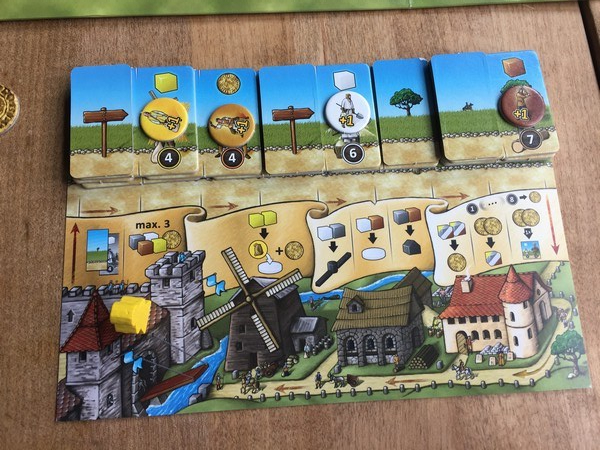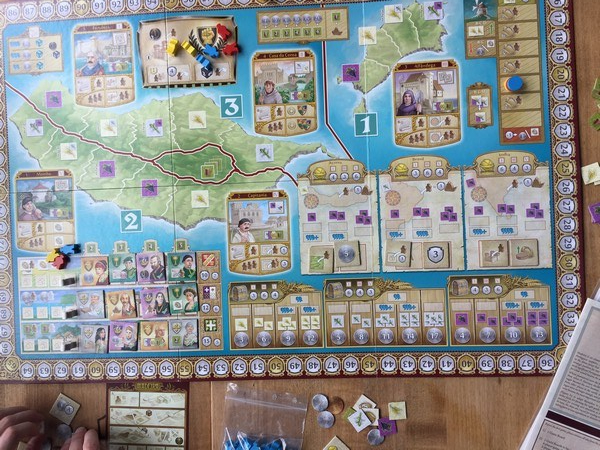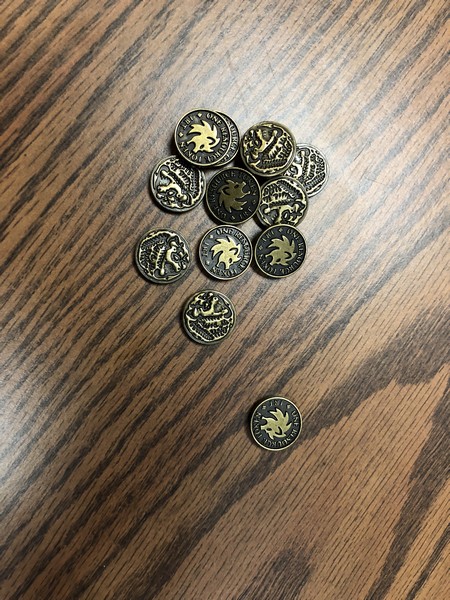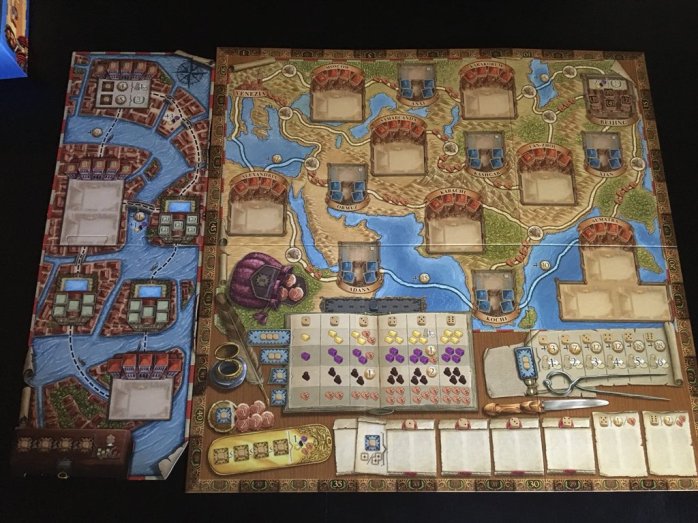Dude! Take Your Turn!
A Gaming Life
New to Me – April 2018
April was an interesting month for the Cult of the New to Me.
First, we had our new member initiation, but nobody came (oops!). (Editor: Doesn’t help that you gave them the wrong date)
Then I took a look at the new to me games this month and found quite the eclectic collection.
There is some Uwe Rosenberg love in here, a couple of small card games, a new expansion for a great game that I haven’t played in a while, and only three of the seven games were published in 2017 or 2018.
That’s true to the new motto of the Cult: “It doesn’t have to be new to be new to me.”
(I’m selling T-Shirts with that, don’t all come to the counter at once, though)
Anyway, without further adieu (Odin ate all the adieu anyway, greedy bastard), let’s get going!
A Feast for Odin (2016 – ZMan Games) – 1 play

Designer: Uwe Rosenberg
Artist: Dennis Lohausen
I have never really been a huge Rosenberg fan, as I’ve bounced hard off of Agricola (will still play the app, though I’m not good at it) and found Caverna to be much more to my taste but still not one I really want to play again.
However, when somebody new came to our game group and brought A Feast for Odin, I decided “why not?” The other choices weren’t that attractive and I had been curious about this one.
And I have to say that, of the three games, this one tops the list for me. It’s still not a “must-play,” but it won’t be one that I actively avoid in the future.
In Agricola, it’s almost impossible to feed your people and get much of an engine going (Editor: This is why Dave isn’t a farmer). Caverna is much more forgiving in that regard, but it still didn’t drive me to play it.
The Patchwork nature of filling your board with differently-shaped tiles to cover up negative points is actually quite attractive. And you’re talking to somebody who is spatially challenged. Yet it was quite intriguing, and while I ultimately failed to do it (I covered my top row with money to take up the spaces, just so I could say I completed it).

For the first time, I felt like I almost had the strategies down, which I still don’t feel in Agricola, even after multiple app plays against various people.
Don’t get me wrong. This isn’t a game that I will request be brought out multiple times. It’s long (about 2.25 hours for us, though two of us were new in a 3-player game) and I don’t enjoy the spatial element *that* much.
But I can say that I won’t be actively avoiding it.
And for me, that’s a win!
La Granja: No Siesta (2016 – Stronghold Games) – 1 play

Designer: Andreas “ode.” Odendahl
Artist: Harald Lieske
La Granja is a classic area-control game from a few years ago that sadly I have not played yet.
However, the dice version is a roll-and-write game with some interesting mechanics.

As with most roll-and-writes, you are going to be rolling dice and marking things off on your playsheet.
The interesting mechanic I found was the dice drafting. The active player will be rolling a number of dice equal to twice the number of players, plus one (thus, in a 4-person game, you’ll be using 9 dice). Each player in order takes a die and takes the resource that’s on the die.
Once everyone has, the active player re-rolls the rest, and players do the same thing.
Finally, the active player rolls the remaining die, and everybody gets that resource.
You can spend the resources by marking off various parts on your sheet with that resource in them. Or, for example, if you have three of them (via rolling three or getting extra resources in certain other ways), you can ship them across the sea. This will give you two points at the end of the game and a “commodity” that can later be used as any resource (except a hat).
You can do various other things, but I’m not going to get into the full details in this short description.
There is a “hat” track that you can spend the hat resources that are rolled/gained to advance your marker along. When you pass certain spots, you will get one of your extra markers (which is important if you want to ship/trade goods later for victory points) and this is also the time track for the game. When somebody reaches the end of it, the game will end.
This was a lot more fun than I thought it would be, and you have a variety of strategies to try and follow (subject to the whims of the dice, of course). You can concentrate on getting roofs for your sheds that will give you points and perhaps extra resources. You can concentrate on shipping or transporting goods across lands.
It took less than an hour to play and it’s pretty good as long as you don’t mind dice games.
Of course, if you hate dice games (Heathens! – Editor), then this will not be a good fit for you.
Milestones (2012 – Stronghold Games) – 1 play

Designers: Stefan Dorra, Ralf zur Linde
Artist: Klemens Franz
Milestones was an interesting game with some cool mechanisms. Players are working together to build roads, market places, and houses in a kingdom.
But they’re not really working together, because you definitely want to build your stuff on prime real estate and get more points. It’s just that you have to build off of what’s already there, so you can’t just jump immediately into the high-value areas.

Each player has their own personal roundel where they move their piece in order to take actions. You can do two actions in a turn.
First, you move along the top and then you swing down and move back along the bottom until you get to the castle again.
You can move as far as you want, but you can’t go backward. Each stop along the top will give you that resource (plus any resources of that same type that you skipped). Along the bottom is where you will use those resources to do things.
You can buy a new worker for your top level (which will be chosen from four that are available), exchange resources and money, and then you can build stuff if you have the right resource. You can even add food to an existing marketplace if you have two yellow cubes.

You’ll be building stuff on the big map.
You get points for building stuff based on the point stones on the map, depending on what you build.
When you’re moving your piece along your roundel, you have to stop at the castle. When you do that, you get taxed. You can only keep three resources in total (so make sure you spend them!).
The king’s also very impressed with your work and will steal one of your workers each time too.
You’ll have to cover up one of the exposed workers on your roundel (you can see that this has been done with the board in the lower right of the above picture).
Continue around and around until somebody reaches the set number of points, and then you will get some end-game points. Whoever has the most is the winner!
This was actually a really fun, though kind of fiddly, game. It took just under an hour plus set-up and teaching time, so it would be a great game for those shorter time periods you might have.
The personal roundel that you end up creating by buying workers is actually quite neat, though constantly covering up individual workers gets kind of annoying. Once both sides of a worker tile are covered, you have to remove it (along with the covering tiles) or else you’re run out of individual covers. It got a little annoying as workers piled up.
I did like how points were scored on the main board, and how you had to watch yourself. You might score a really nice number of points by placing that road, but that opens up an extremely lucrative market place opportunity for the next player. I managed to score a huge number of points by setting myself up for a double placement over two turns when my opponents were not in position to do anything about it.
I’d definitely play this again, though it’s not on my must-play list.
Madeira (2013 – What’s Your Game) – 1 play

Designers: Nuno Bizarro Sentieiro, Paulo Soledade
Artist: Mariano Iannelli
Madeira is an island discovered by Portugal in the 15th century, situated in the mid-Atlantic. It’s also the Portuguese word for “wood.” Which is good.
Because there’s a lot of freaking wood in this game.

The map is of the island, with another small island next to it and then three other colonial locations.
And then a lot of other stuff.
It really looks more complicated than it is, but getting to the point of understanding it can be a bit of a bear.

Basically, you are positioning your workers and your ships out on the board in order to gain resources and do other things that will eventually let you fulfill the king’s requests and thus get you victory points (the king really hands out victory points like candy).
The gameplay is pretty straightforward, involving some dice mechanics, some pirates (PIRATES, BAD! Though only if you have more than everybody else), bread to feed your workers and lots of freaking wood to keep your ships in top shape.
I’m not going to go into great detail about how the game works (save that for a review if I ever play it enough), but basically you will be rolling dice and assigning these dice to one of five different spaces. You take an action there as soon as you place the die.
Then, after all dice are placed (including Pirate Dice, if any), each area is activated in numerical order. All the non-Pirate dice are rolled, that total is subtracted from a number depending on the number of players (for 3 players, it was 9), and that is the cost to do the other action in that spot.

These actions can be anything from sending ships to a colony, to trade goods, harvest resources, add your people to the city or rearrange them to get resources, and things like that.
If you can’t afford or don’t want to do the action, you will get pirates. If you don’t have enough bread to feed your people, you will get pirates (I guess you’re buying food from the black market). If you don’t have enough wood and can’t afford to buy enough wood to upkeep your ships, you will get pirates (being a pirate in this game is quite lucrative!)
After five rounds, where a total of six King’s Requests are scored, the game ends and any other victory points are tallied. In addition, whoever has the most pirates will lose 16 points, and second most will lose a certain number less than 16 points (Editor: Dave’s too lazy to look that up right now). Whoever has the fewest pirates will not lose any points.
(Don’t worry, there are ways to get rid of pirates during the game).
I really liked this game. It’s a bit of a brain-burner, but it burns in a good way. It’s a very delicate balancing act to make sure you have enough resources to get done what you want to do.
You can’t be afraid to get pirates because if you are, you will not be able to do everything you need to do. There won’t be enough resources to go around. But pirate mitigation is key, and you also have to figure out when it’s time to start getting rid of them instead of getting more.
Part of the dice-selection is choosing the King’s Request(s) that go along with them, so it’s possible that the best dice rolled may not actually benefit you if the available Requests are bad.
It helps that I won our first game, though I think we got a rule or two wrong so it has an asterisk by it.
I can’t wait to play it again and see what I can do.
It’s also available on Boardgame Arena if you’re interested in playing online (let me know in the comments!)
Also, it sounds like a 2nd edition of the game will be coming out in the near future (or will be coming to Kickstarter, anyway). So keep your eye out!
Fugitive (2017 – Fowers Games) – 3 plays (owned)

Designer: Tim Fowers
Artist: Ryan Goldsberry
This is an excellent 2-player game of cat and mouse, with cards!
Beautiful artwork and innovative gameplay make this a standout.
But don’t just listen to me. You can read the review of it here.
(Oh, that’s by me too…so I guess you are still listening to me)
The Flow of History (2018 – Tasty Minstrel Games) – 2 plays (owned)

Designer: Jesse Li
Artists: Desnet Amane, SY Li, Adam P. McIver
(The game originally came out in 2016 but was redone by Tasty Minstrel Games and put on Kickstarter. I backed the Deluxified Edition and it arrived a couple of weeks ago)
This game looks gorgeous, though the errors in the rulebook card glossary are a bit annoying. Thankfully, the cards are right so as long as you know the iconography, you’re fine.
This is a relatively light civilization building game using cards, and it’s really interesting.

Cards come out into the market in a series of ages, and it has a great mechanic for gaining those cards to your civilization.

You have a number of resource tokens, and you choose a card that you want to “invest” in by placing a number of resources underneath them. If it gets around to you again, then you can take the card, paying the invested resources to the Supply. Then, you may get an investor bonus depending on which icon is in the bonus part of the card and how many of that icon you have in your civilization.

You then place that card in your tableau, covering a card of the same colour if you have one. You then do the action on that card if it’s an immediate action. Or perhaps the card will give you a benefit as long as it’s on top of its pile.
But you may not get the card.
Somebody can snipe you, in which case they pay you the same amount that you invested. The investment goes to the Supply. If you have any trade icons showing, you take that many resources from the Supply. You then also get half of the remaining tokens in the Supply.
I liked that aspect of the game, because it makes it not as annoying when somebody takes your card. You may get a ton of resources!
The game was really fun, at least for the first couple of games. It’s intriguing enough that I definitely want to play it more often (I would anyway, since I Kickstarted it and I want it to be worth what I paid, but I’d be interested even if it wasn’t my game).
And maybe I won’t come in dead last once.
The Expanse Board Game (2017 – Wizkids) – 1 play

Designer: Geoff Engelstein
Artist: N/A
This is the board game based on the science fiction TV show. It’s a game of political intrigue, area control, and a little bit of light combat, and it’s actually pretty cool.
Would probably be even better if we had played by the right final scoring rules! But that just makes me want to play it again.

In the game, you are one of four factions who are vying for control of resources and political influence among the planets of our solar system.

I was the OPA (Outer Planets Alliance, a group that started out as sort of a trade union and grew from there), so my faction was strongest in the Belt and Outer Planets (even able to place influence out there without having a fleet).

The game has a bit of a Twilight Struggle for multiple players feel to it, in the sense that the game is largely done through card play and action points. The cards can be used for either their event or for their action points.
The twist in this game is that the cards are freely available to purchase for Command Points (victory points as currency!) or you can take the free one at the end of the row. They are not dealt out and secret.
Each event can only be done by certain factions. If your faction isn’t shown above the event, you have to take the card for the action points, which allow you to do things such as place influence, destroy fleets, build fleets if you’ve had one destroyed, or things like that.
If you don’t do the event, then one of the factions shown on the card can then do that event instead, with the choice going in initiative order. If it’s not your turn and you decide to do the event, then your marker is placed at the bottom of the initiative track and then you execute it as if it were your turn.
Once the event is activated, the card is discarded.
You can also spend one Command Point to keep the card and execute it later, if you wish. Including right before scoring happens.
Scoring is interesting because you have to spend your turn “buying” the score card, but that gives you the chance to direct the scoring to where you are strongest. Each scoring round until the final one, the player who buys the card chooses one of the scoring tiles as a “bonus area.” Each sector (Inner Planets, The Belt, Outer Planets) can be chosen at most twice during the game.

Each player then gets a chance to play a “kept” event or, if they control the Rocinante, they can do one of those actions.
Then scoring is done. In the two non-bonus sectors, each base (the rectangles where the cubes are in the picture above) scores one CP to whomever has the most influence there. There are variables for that, but I’ll save the whole “how to play” for any review I do.
The bonus sector gives first and second (and, in later rounds, third) place points to whomever has the most influence. Thus, when you choose the scoring card, if possible you want to make sure you’re going to get most of the first-place points.
The game ends when the final scoring card hits the market (assuming you’re not us and you actually play it right)
Fans of the show will like how the Rocinante is handled (the 4-person crew are kind of the heroes of the show). The Rocinante in the game is an independent ship that operates as a fleet for whoever controls it. After each scoring round, the Rocinante control is given to whomever is in last place on the CP track.
It’s a nice bonus for being last.
The Expanse is an intricate tug-of-war with asymmetric abilities that is really juicy. I really loved the brain-burning decisions: do I take the card for the action points because I need to move ships or place influence, but then that lets the card event be used by an opponent and it might be used against you.
Which is more important? Do I spend an actual victory point to keep that card until later?
Argh!!!!!!!
But it burns in a good way.
I really want to play this game again, with the right final scoring.
It seems like a brilliant design by Engelstein.
Expansion New to Me
The Voyages of Marco Polo: Agents of Venice (2017 – ZMan Games) – 1 play

Designers: Simone Luciani, Daniele Tascini
Artist: Dennis Lohausen
I loved the dice-placement game The Voyages of Marco Polo, mainly for its innovative way of placing dice in certain places to do things, but then requiring you to pay extra money if somebody’s already been to that place (certain places are only available to the first person).

There were so many avenues to score points and win, depending on the character you chose.
It’s been over a year since I played it, but it was brought out again a couple of weeks ago and the owner also had the Agents expansion. We just used the Venice part of it, not the Companions, though looking at the rulebook, I’d like to try it again with them one of these days.

The Venice board gives you more places to place your dice, new city cards to give you actions, and certainly more ways to get victory points.
This expansion broadens the board a bit, adds a 5th player (which means you definitely need those extra spaces) and is just a great addition to the base game. It adds very little complexity and a few more options/strategies.
The perfect kind of expansion.
We also played with the “New Characters” expansion, but only the “gifts” which allow you to earn a one-time bonus, either immediate or something you can hold on to and use it when you need it.
I’d happily try both again, and this time with the Companions *and* with some of the new characters from either expansion (we stuck with the base game characters)
So what new games have you played? Let me know in the comments.
New to me this month was Hansa Teutonica and Century: Golem Edition. I really enjoyed both and I now understand the appeal of Golem Edition over Spice Road (so pretty).
LikeLiked by 2 people
Haven’t played Hansa Teutonica yet, but I love Century! I do agree that the Golem edition looks better. It’s too bad that subsequent expansions won’t take that into account.
How is Hansa?
LikeLiked by 1 person
Hansa was fun. It can be a bit mean since players can block others and make it more difficult to complete routes. We played on an expansion map (I do not know which one) and I really enjoyed it. It played rather quickly too for having 5 playefs
LikeLiked by 1 person
Nice! A friend of mine has it. I may have to request it so it can show up on a later “New to Me” post. 🙂
LikeLike
I really like these posts, though my goodness, must take an age to write! Also I was really excited to get behind The Flow of History, but backed out at the last second. It sounds like it’s a lot of fun. Drats!
For me, I think the only new games were Bargain Quest and Tash-Kalar. Not quite as exciting!
LikeLiked by 1 person
Three months ago I started writing them as I played the games. Made the end of the month a lot easier. Usually at that point, I just have the introduction to write and some polishing. 🙂 Maybe one or two more games if I get a new one in on the last couple of days.
Flow of History is great, but I have to play it a couple more times before I decide about the ending of the game.
LikeLike
Pingback: Boardgame Geek Top 100 – Played or Play? #30-21 – Dude! Take Your Turn!
Pingback: Boardgame Geek Top 200 – Play or Played – #160-151 – Dude! Take Your Turn!
Pingback: March 2024 Gaming – Dude! Take Your Turn!